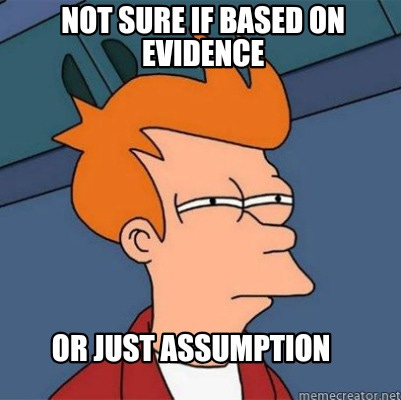Rule #2: There are always underlying assumptions.
When properly assessing any conclusion, it is essential to enumerate the underlying assumptions.
Every decision rests on assumptions. At minimum, you’re assuming the options you’re considering are actually all of your options. This set of options is, in turn, based on a set of assumed facts, which is, in turn, based on even more assumptions about how the world works.
I’ve seen this pattern repeatedly: teams spend hours debating the details of Option A versus Option B, only to discover they never considered Option C—or that their entire framing of the problem was based on outdated or misaligned assumptions. Generally, in these situations, or for any significant decision, it’s worth taking some time to literally enumerate the relevant assumptions and why they should be relied upon in this particular situation.
This process of enumerating assumptions is almost always illuminating in some way. Often, it reveals that particular assumptions need further de-risking. From our book Super Thinking:
You can de-risk anything: a policy idea, a vacation plan, a workout routine. When de-risking, you want to test assumptions quickly and easily. Take a vacation plan. Assumptions could be around cost (I can afford this vacation), satisfaction (I will enjoy this vacation), coordination (my relatives can join me on this vacation), etc. Here, de-risking is as easy as doing a few minutes of online research, reading reviews, and sending an email to your relatives.
Or, in the context of a startup idea, also from our book:
My team can build our product—We have the right number and type of engineers; our engineers have the right expertise; our product can be built in a reasonable amount of time; etc.
People will want our product—Our product solves the problem we think it does; our product is simple enough to use; our product has the critical features needed for success; etc.
Our product will generate profit—We can charge more for our product than it costs to make and market it; we have good messaging to market our product; we can sell enough of our product to cover our fixed costs; etc.
We will be able to fend off competitors—We can protect our intellectual property; we are doing something that is difficult to copy; we can build a trusted brand; etc.
The market is large enough for a long-term business opportunity—There are enough people out there who will want to buy our product; the market for our product is growing rapidly; the bigger we get, the more profit we can make; etc.
Enumerating assumptions can seem pedantic, but I've found it extremely helpful because it clarifies your argument, much like writing a blog post or explaining something to someone in real-time. It helps ensure you’re drawing a logical conclusion from your assumptions.
A great way to help identify potentially shaky assumptions is to conduct a premortem. Here’s the template we use at DuckDuckGo for new project premortems:
Premortem
Many projects fail to meet their success criteria, so take some time to be pessimistic and ask questions:
What are the key risks to this project and how can they be mitigated?
What could slow down this project and how can we prevent that from happening?
How might our actions in this project negatively affect user trust or be misunderstood?
The goal is to uncover problems or blindspots and then decide how to address them up front, such as by starting with the most uncertain part. If a project is destined to fail, failing fast is a success.
This principle extends beyond individual and team decisions to broader discourse. I'm constantly frustrated by political and policy debates where participants talk past each other—often because they're operating from different underlying assumptions or facts. If it is a good faith debate, then there should be the opportunity to enumerate and drill down on those underlying assumptions and facts, which can then help clarify exactly where the disagreement is occurring. For example, it might turn on just one misaligned assumption or fact among many. If that’s the case, a determination can be made on what specific evidence would be compelling enough to achieve alignment.
Rule #2—There are always underlying assumptions—is universal. You're always making assumptions. The key is examining them before they lead you astray.
See other Rules.



Great post. Enumerating assumptions is one of the fastest ways to surface blind spots, reduce friction, and make better bets. I especially appreciate the link to premortems- it's such an underused leadership tool.
I wrote about premortems recently in ‘The Secret to Smarter Strategy? Pretend It Already Failed’:
https://www.linkedin.com/pulse/secret-smarter-strategy-pretend-already-failed-kathryn-fulton-23yfc/